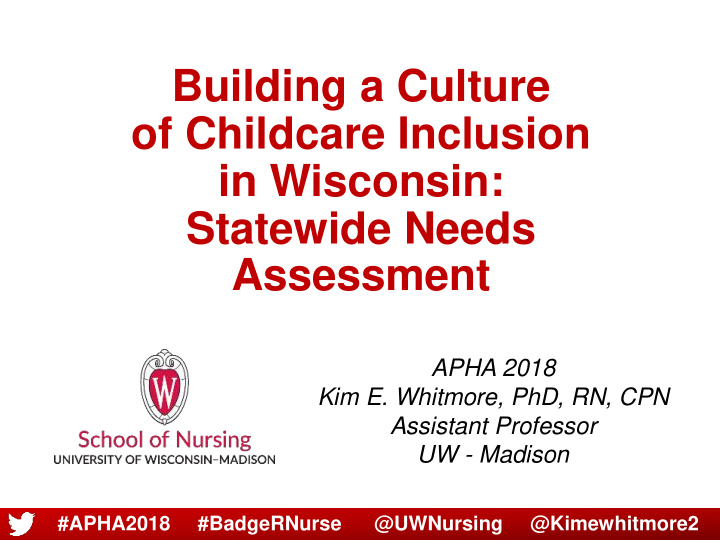



Building a Culture of Childcare Inclusion in Wisconsin: Statewide Needs Assessment APHA 2018 Kim E. Whitmore, PhD, RN, CPN Assistant Professor UW - Madison #APHA2018 #BadgeRNurse @UWNursing @Kimewhitmore2
Presenter Disclosure Kim E. Whitmore The following personal financial relationships with commercial interests relevant to this presentation existed during the past 12 months: No relationships to disclose.
Background & Significance Over 200,000 (15.5%) children with special healthcare needs (CSHCN) in WI Defined as “those who have or are at increased risk for a chronic physical, developmental, behavioral, or emotional condition and who also require health and related services of a type or amount beyond that required by children generally” (The Child & Adolescent Health Measurement Initiative, 2012) #APHA2018 #BadgeRNurse @UWNursing @Kimewhitmore2
Childcare Inclusion Inclusion: educating or caring for CSHCN in the same environment as children of typical development (Youngstar, n.d.) 2015 Federal Policy Statement #APHA2018 #BadgeRNurse @UWNursing @Kimewhitmore2
Childcare Inclusion in WI 58% of childcare providers in WI report lack of knowledge and confidence (Wisconsin Early Childhood Association, 2015) Current practices/initiatives Over 30% turnover rate of childcare providers (Wisconsin Early Childhood Association, 2016) #APHA2018 #BadgeRNurse @UWNursing @Kimewhitmore2
Childcare Provider or Nurse?
Family Impact ~75% parents report a family member cut-down or quit work (Whitmore, in review) Potential negative family outcomes Loss of income Decreased economic stability Social isolation Stress poor health outcomes #APHA2018 #BadgeRNurse @UWNursing @Kimewhitmore2
Study Purpose 1. To describe current practices and barriers regarding care of CSHCN by licensed childcare providers in Wisconsin 2. To gauge interest in a web-based, easily accessible training resource for childcare providers #APHA2018 #BadgeRNurse @UWNursing @Kimewhitmore2
Methods Online Qualtrics survey Childcare directors (~2,300) Childcare providers (~20,000) Distributed by the Wisconsin Department of Children and Families #APHA2018 #BadgeRNurse @UWNursing @Kimewhitmore2
Methods: Survey Design Developed in partnership with: 15-member Community Advisory Board (CAB) UW Survey Center Topics included: Personal experience Training capability and confidence Barriers and challenges Interest in eSchoolcare #APHA2018 #BadgeRNurse @UWNursing @Kimewhitmore2
What is eSchoolcare? Developed with HRSA funding in 2011 at UW- Madison School of Nursing for school nurses Web-based mobile resource Expert-reviewed, evidence-based information Content updated regularly Cost-effective sustainable solution https://eschoolcare.nursing.wisc.edu/ #APHA2018 #BadgeRNurse @UWNursing @Kimewhitmore2
Anticipated Results Understanding of current practices and barriers Identify greatest training needs Gauge interest in eSchooolcare use Identify barriers to eSchoolcare use Inform next steps of larger project #APHA2018 #BadgeRNurse @UWNursing @Kimewhitmore2
Next Steps Develop test module based on highest need Pilot project with 125 childcare centers Pre/post knowledge and confidence assessments Program satisfaction Program utilization Study of childcare experiences of parents #APHA2018 #BadgeRNurse @UWNursing @Kimewhitmore2
Implications Increased quality of care for CSHCN Build a culture of childcare inclusion Greater childcare utilization Improve family outcomes #APHA2018 #BadgeRNurse @UWNursing @Kimewhitmore2
Acknowledgements Community Advisory Research Team Board Lori Anderson Abby Hammes Statewide Early Junha Park Childcare Inclusion Kayla Van Boxtel Committee Childcare Funding 2017 Research providers/directors Committee Award Families of CSHCN from the School of Nursing, University of Wisconsin-Madison #APHA2018 #BadgeRNurse @UWNursing @Kimewhitmore2
Thank You! Kim E. Whitmore, PhD, RN, CPN kim.whitmore@wisc.edu 414-403-2699 #APHA2018 #BadgeRNurse @UWNursing @Kimewhitmore2
References Child and Adolescent Health Measurement Initiative. 2009/2010 National Survey of Children with Special Health Needs, Data Resource Center for Child and Adolescent Health website. Retrieved from http://www.childhealthdata.org/learn/NS-CSHCN. Child and Adolescent Health Measurement Initiative (2012). “Who Are Children with Special Health Care Needs (CSHCN).” Data Resource Center, supported by Cooperative Agreement 1 ‐ U59 ‐ MC06980 ‐ 01 from the U.S. Department of Health and Human Services, Health Resources and Services Administration (HRSA), Maternal and Child Health Bureau (MCHB). Image from slide 15: [Photograph found in North Carolina Department of Health and Human Services]. (2018, June 15). Retrieved November 9, 2018, from https://www.ncdhhs.gov/blog/2018-06-15/dhhs-has-help-line- children-special-health-care-needs #APHA2018 #BadgeRNurse @UWNursing @Kimewhitmore2
References Whitmore, K. (In Review). Factors associated with unmet respite care needs in families of children with and without autism spectrum disorder. Wisconsin Department of Children and Families (2016). What’s working: Inclusion efforts in WI. Retrieved from https://dcf.wisconsin.gov/files/youngstar/pdf/eci/trainings/inclusion wisconsinppt.pdf. Wisconsin Early Childhood Association. (2016).Child care matters: 2016 annual report. Retrieved from http://wisconsinearlychildhood.org/assets/2016-Annual- Report/WECA-2016-Annual-Report-Web.pdf. Youngstar. (n.d.). Be an inclusive child care provider. Retrieved from https://dcf.wisconsin.gov/files/youngstar/pdf/eci/inclusiveprovider.p df. #APHA2018 #BadgeRNurse @UWNursing @Kimewhitmore2
Recommend
More recommend